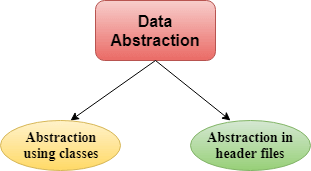TheDeveloperBlog.com
C-Sharp | Java | Python | Swift | GO | WPF | Ruby | Scala | F# | JavaScript | SQL | PHP | Angular | HTML
Data Abstraction in C++
Data Abstraction in C++ tutorial for beginners and professionals with examples on constructor, if-else, switch, break, continue, comments, arrays, object and class, exception, static, structs, inheritance, aggregation etc.
Data Abstraction in C++
In C++ program if we implement class with private and public members then it is an example of data abstraction. Data Abstraction can be achieved in two ways:

Abstraction using classes: An abstraction can be achieved using classes. A class is used to group all the data members and member functions into a single unit by using the access specifiers. A class has the responsibility to determine which data member is to be visible outside and which is not. Abstraction in header files: An another type of abstraction is header file. For example, pow() function available is used to calculate the power of a number without actually knowing which algorithm function uses to calculate the power. Thus, we can say that header files hides all the implementation details from the user. Access Specifiers Implement Abstraction:
Let's see a simple example of abstraction in header files. // program to calculate the power of a number.
#include <iostream>
#include<math.h>
using namespace std;
int main()
{
int n = 4;
int power = 3;
int result = pow(n,power); // pow(n,power) is the power function
std::cout << "Cube of n is : " <<result<< std::endl;
return 0;
}
Output: Cube of n is : 64 In the above example, pow() function is used to calculate 4 raised to the power 3. The pow() function is present in the math.h header file in which all the implementation details of the pow() function is hidden. Let's see a simple example of data abstraction using classes.
#include <iostream>
using namespace std;
class Sum
{
private: int x, y, z; // private variables
public:
void add()
{
cout<<"Enter two numbers: ";
cin>>x>>y;
z= x+y;
cout<<"Sum of two number is: "<<z<<endl;
}
};
int main()
{
Sum sm;
sm.add();
return 0;
}
Output: Enter two numbers: 3 6 Sum of two number is: 9 In the above example, abstraction is achieved using classes. A class 'Sum' contains the private members x, y and z are only accessible by the member functions of the class. Advantages Of Abstraction:
Next Topic#
|
Related Links:
- Data Mining Architecture
- Data Structures | DS Tutorial
- Computer Network | Data Link Controls
- DS for symbols tables
- Data Preprocessing in Machine learning
- Data Mining Tools
- Data Mining vs Machine Learning
- What is Data Science: Tutorial, Components, Tools, Life Cycle, Applications
- DS Algorithm
- DS Asymptotic Analysis
- Data Flow in Angular 7 Forms
- Data Mining Tutorial
- Data Mining Cluster Analysis
- Data Mining vs Data Warehousing
- DS Structure
- DS Array
- DS 2D Array
- DS Quene
- Different types of Clustering Algorithm
- Data Mining vs Big Data
- Data Mining Bayesian Classification
- Data Mining World Wide Web
- Data Types in C
- Verbal Reasoning | Data Sufficiency 2
- Data Mining Techniques
- DS Introduction
- Data Structure Interview Questions (2021)
- Verbal Reasoning | Data Sufficiency 1
- Top 25 Data Science Interview Questions (2021)
- Data Warehouse Tutorial
- Data Flow in MapReduce
- DS Stack
- Data Abstraction in C++
- Top 25 Data Warehouse Interview Questions (2021)
- Data Link layer
- Data Security Considerations
- DS Pointer

